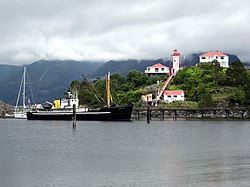Yuquot
| Yuquot | |
|---|---|
| Friendly Cove | |
 Nootka Lighthouse overlooking Yuquot | |
| Location | Nootka Island in Nootka Sound, just west of Vancouver Island, Gold River, British Columbia, Canada |
| Governing body | Mowachaht/Muchalaht First Nations |
| Website | https://www.yuquot.ca/ |
Yuquot /ˈjuːkwɔːt/, also known as Friendly Cove, is a small settlement of around six people - The Williams family of the Mowachaht band, plus two full-time lighthouse keepers, located on Nootka Island in Nootka Sound, just west of Vancouver Island, British Columbia, Canada. It was the summer home of Chief Maquinna and the Mowachaht/Muchalaht (Nuu-chah-nulth) people for generations, housing approximately 1,500 natives in 20 traditional wooden longhouses. The name means "Wind comes from all directions" in Nuu-chah-nulth.
The community is located within the Strathcona Regional District but like all Indian Reserve communities is not governed by nor represented in the regional district. The Mowchaht/Muchalaht First Nations are rather part of the Nuu-chah-nulth Tribal Council, which unites the governments of the indigenous communities of the Island's West Coast.
The Canadian government declared Friendly Cove a National Historic Site in 1923, with recognition of the significance of the Spanish colonial settlement that was once there and First Nations history following in 1997.
History
Early exploration and settlement

Yuquot had been occupied for over 4,300 years by First Nations peoples of the Nootka Sound region. In the late 18th century, Nootka Sound became an important site of early contact between First Nations of the Pacific Northwest and European explorers, and developed into a centre of maritime fur trade.[1]
In 1774, Spanish explorer Juan José Pérez Hernández became the first European to spot Yuquot. The region was formally claimed as part of the Spanish Empire in a subsequent voyage by Spanish-Basque explorer Bruno de Heceta in 1775.
On 5 May 1789, Spanish navigator and explorer Esteban José Martínez established the settlement of Santa Cruz de Nuca. It was the first European colony in what is now British Columbia, the only Spanish settlement in what is now Canada, and the northernmost verified Spanish settlement in the Americas. The colony was protected by the canon of Fort San Miguel and was maintained until the resolution of the Nootka Crisis in 1795.
Nootka Crisis
Yuquot was the scene of the Nootka Crisis, which nearly led to war between Spain and Britain. Negotiations in Europe calmed the situation and led to the first Nootka Convention. Each nation sent a commissioner to Nootka Sound in order to carry out the terms of the Nootka Convention and related diplomatic issues. Arriving in 1792, George Vancouver was commissioner for Britain and Juan Francisco de la Bodega y Quadra for Spain. Quadra also served as the commandant of the Spanish settlement at Yuquot, hosting Vancouver and his crew. Quadra and Vancouver had to engage in diplomatic negotiations due to the Nootka Convention's vagueness and lack of detail over how it was to be implemented. In addition both commissioners had been given incomplete, differing, and confused instructions by their governments. They negotiated for months but in the end failed to reach an agreement. The matter was sent back to the British and Spanish governments.
The primary problem was a differing interpretation of the Nootka Convention. Vancouver's position, as instructed, was that the entire Spanish settlement was to be turned over to him. Quadra's position was that there was nothing left to turn over in accord with the Nootka Convention, but he made various offers, such as turning over a small cove in Nootka Sound, where John Meares had built the North West America in 1788, or turning over the entire settlement in exchange if Britain agreed to set the boundary between Spanish and British territory at the Strait of Juan de Fuca. Chief Maquinna played a role in the negotiations, identifying the cove where Meares had built his vessel, swearing that no land had ever been sold to the British and that the Spanish were the rightful occupants at Yuquot—and that only on the condition that the site be restored to his people as soon as possible. Unable to reach an agreement, Vancouver and Quadra left in late 1792 and the settlement at Yuquot remained under Spanish control until 1795, when the terms of the third Nootka Convention, calling for the "mutual abandonment" of Nootka, were carried out, after which the site was reoccupied by the Maquinna and the Mowachaht people.
19th century
John R. Jewitt, an English blacksmith, was held there for three years 1803-1805 as Maquinna's slave, following the capture of the trading ship Boston and the deaths of the captain and all but one other crew members. Jewitt's memoirs form an important record of Yuquot at that period.
20th century
In 1911, the government of Canada erected the Nootka Lighthouse atop San Rafael Island, a small rocky island that overlooks Yuquot and forms part of its natural harbour. The original lighthouse was later replaced with the current lighthouse in 1958. It serves as a navigational aid to vessels transiting Nootka Sound.[1]
See also
References
- ^ a b "Nootka Lighthouse". www.pc.gc.ca. Retrieved 2020-07-29.
